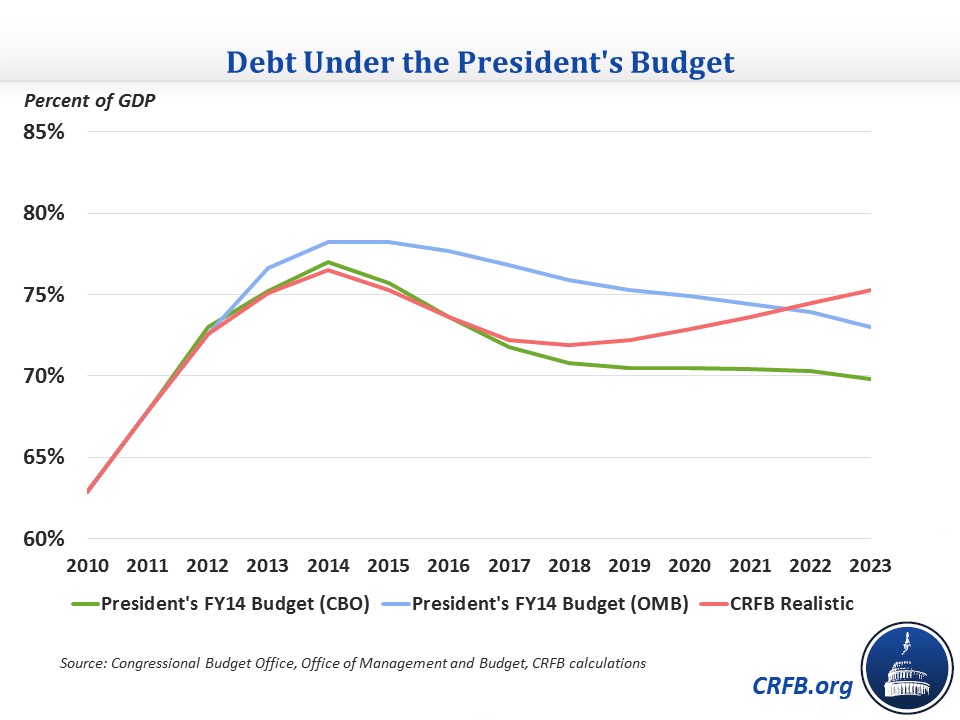CBO Releases Analysis of President Obama's FY 2014 Budget
Today, the Congressional Budget Office (CBO) released its analysis of President Obama’s FY 2014 budget request. CRFB has released a reaction to the score of the budget, praising the President for putting forward a deficit reduction offer that addresses the country's debt path, but warning that there would still need to be more done, particularly on entitlement spending.
As we wrote in our analysis on the OMB's estimates, the President’s budget does put debt on a downward path as a share of the economy, a key goal for fiscal responsibility. The CBO analyzed the whole budget and predicted that if his proposal were enacted, the debt would rise 75.2 percent of GDP to a peak of 77 percent of GDP in 2014 to before falling gradually to 69.8 percent by 2023. These debt levels are actually slightly lower than the White House’s initial projections from April due to the lower baseline projections for debt, as OMB's scored savings are close to CBO's estimates.

The President had proposed his budget in two parts, the savings from his final deficit reduction offer in the fiscal cliff negotiations comprising the first part and other priorities comprising the second part. CBO examines the budget as a whole and finds that compared to current law, the President's budget would reduce deficits by $1.1 trillion, or $1.6 trillion compared to CRFB's Realistic baseline.
| CBO Estimates of the President's Budget (percent of GDP) | |||||||||||
| 2014 | 2015 | 2016 | 2017 | 2018 | 2019 | 2020 | 2021 | 2022 | 2023 | 2014-2023 | |
| Revenue | 18.4 | 19.5 | 19.6 | 19.4 | 19.3 | 19.2 | 19.2 | 19.4 | 19.6 | 19.7 | 19.4 |
| Spending | 22.5 | 22.0 | 21.8 | 21.4 | 21.3 | 21.6 | 21.8 | 21.8 | 22.0 | 21.8 | 21.8 |
| Deficits | 4.1 | 2.5 | 2.2 | 2.0 | 2.0 | 2.4 | 2.5 | 2.4 | 2.4 | 2.1 | 2.4 |
| Debt | 77.0 | 75.7 | 73.6 | 71.8 | 70.8 | 70.5 | 70.5 | 70.4 | 70.3 | 69.8 | N/A |
| OMB Estimates (percent of GDP) | |||||||||||
| Revenue | 17.8 | 18.6 | 18.8 | 18.8 | 18.9 | 19.2 | 19.4 | 19.6 | 19.8 | 20.0 | 19.1 |
| Spending | 22.2 | 21.8 | 21.6 | 21.3 | 21.2 | 21.5 | 21.6 | 21.7 | 21.9 | 21.7 | 21.6 |
| Deficits | 4.4 | 3.2 | 2.8 | 2.4 | 2.3 | 2.3 | 2.2 | 2.1 | 2.1 | 1.7 | 2.5 |
| Debt | 78.2 | 78.2 | 77.7 | 76.8 | 75.9 | 75.3 | 74.9 | 74.4 | 73.9 | 73.0 | N/A |
Source: CBO, OMB
Under the President's budget, spending would be 21.8 percent of GDP by 2023 while revenues would rise to 19.7 percent of GDP. As a result, deficits under the President's budget would fall from 4.2 percent of GDP in 2013 to 2.1 percent by 2023.
The budget is an encouraging effort to get serious about deficit reduction, but it also underscores how much work is left to be done. With the compromises of the past two years, Congress has made some solid progress, but more remains to be done. Our analysis of the CBO’s recent budget projections found that $2.2 trillion in additional savings are needed to put the debt on a clear downward path as a percentage of the economy.
Lawmakers should use the budget negotiations as an impetus to have an honest discussion about our nation’s fiscal future and come to compromise that will rein in debt over the long term and encourage future economic growth. As CRFB President Maya MacGuineas said in our reaction to the CBO analysis:
It is encouraging to see that the President’s proposals would indeed begin to reduce the debt – and to lower levels than originally thought. However, the debt would just barely be falling, meaning that any small change in projections could bump it back up. Regardless, additional reforms will be needed over the long-term, especially to slow the growth of health care programs and shore up Social Security.
Click here to read our release on the CBO analysis.


